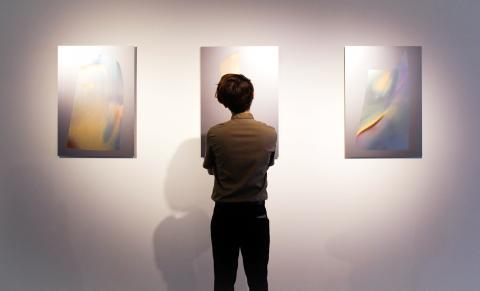After experiencing the Arctic’s midnight sun and polar nights, London-based artist Jessica Rayner found inspiration in the role of light in human life.
“This [experience] made me question what happens when our main source of light — the sun — isn’t available to us?” Rayner said via Skype at the launch of her Faces of Light exhibition at Taipei’s Bluerider Art Gallery on Saturday.
Her first solo exhibition in Asia is an attempt to answer that question.

Photo: Sofia Kuan
Light, darkness and color all work together in her collection to show how they shape the way we perceive ourselves and the world around us. Visitors on Saturday were mainly drawn to the diverse uses of dancing lights and hues in all the pieces, and the strong emotions these convey. Throughout all her works, Rayner uses inanimate objects like orbs, lenses, glass and prisms to capture images that are impossible to see with the naked eye.
The series Awareness of the Light shows Rayner’s ability to draw on the surrounding environment as a means to create art. Visitors to the gallery are welcomed by four aluminum canvases etched with what seems to be a dancing rainbow, but are, in fact, a large plastic Fresnel Lens, a kind of prism, hung in front of a window. She allowed it to dance as the sun’s rays broke through it, capturing a choreography of movement and color.
BEFORE NEWTON
Rayner also brings the viewer back in time with the Before Newton series. These are gray scale glass paintings that are meant to represent how people perceived objects and light before Newton’s discovery of the color spectrum.
The images are more jagged and geometrical in comparison to the rest of the works but they strongly suggest a time when concepts of light were more rigid.
“Everything has a history and story of process and that is something that I’m very interested in with my work,” Rayner said.
In her series Afterimage, Rayner experimented with the change of light throughout the day by photographing square prisms using a Polaroid camera and different filters. The resulting images are colorful yet unclear and off-focus, but purposely so.
Rayner said that her pieces are an attempt to communicate feelings and states of being that are open to interpretation rather than straightforward messages.
At a time when much of the media we consume is over processed and leaves little room for the imagination, it’s refreshing to encounter young artists like Rayner, who employ an abstract yet unpretentious approach.
“Nothing is objective, we are constantly evolving,” Rayner said. “I want [my art] to be more of a mood and an experience and the idea that we are in the midst of a long history. We are here just for a moment in time.”

When nature calls, Masana Izawa has followed the same routine for more than 50 years: heading out to the woods in Japan, dropping his pants and doing as bears do. “We survive by eating other living things. But you can give faeces back to nature so that organisms in the soil can decompose them,” the 74-year-old said. “This means you are giving life back. What could be a more sublime act?” “Fundo-shi” (“poop-soil master”) Izawa is something of a celebrity in Japan, publishing books, delivering lectures and appearing in a documentary. People flock to his “Poopland” and centuries-old wooden “Fundo-an” (“poop-soil house”) in

Jan 13 to Jan 19 Yang Jen-huang (楊仁煌) recalls being slapped by his father when he asked about their Sakizaya heritage, telling him to never mention it otherwise they’ll be killed. “Only then did I start learning about the Karewan Incident,” he tells Mayaw Kilang in “The social culture and ethnic identification of the Sakizaya” (撒奇萊雅族的社會文化與民族認定). “Many of our elders are reluctant to call themselves Sakizaya, and are accustomed to living in Amis (Pangcah) society. Therefore, it’s up to the younger generation to push for official recognition, because there’s still a taboo with the older people.” Although the Sakizaya became Taiwan’s 13th

For anyone on board the train looking out the window, it must have been a strange sight. The same foreigner stood outside waving at them four different times within ten minutes, three times on the left and once on the right, his face getting redder and sweatier each time. At this unique location, it’s actually possible to beat the train up the mountain on foot, though only with extreme effort. For the average hiker, the Dulishan Trail is still a great place to get some exercise and see the train — at least once — as it makes its way

Earlier this month, a Hong Kong ship, Shunxin-39, was identified as the ship that had cut telecom cables on the seabed north of Keelung. The ship, owned out of Hong Kong and variously described as registered in Cameroon (as Shunxin-39) and Tanzania (as Xinshun-39), was originally People’s Republic of China (PRC)-flagged, but changed registries in 2024, according to Maritime Executive magazine. The Financial Times published tracking data for the ship showing it crossing a number of undersea cables off northern Taiwan over the course of several days. The intent was clear. Shunxin-39, which according to the Taiwan Coast Guard was crewed